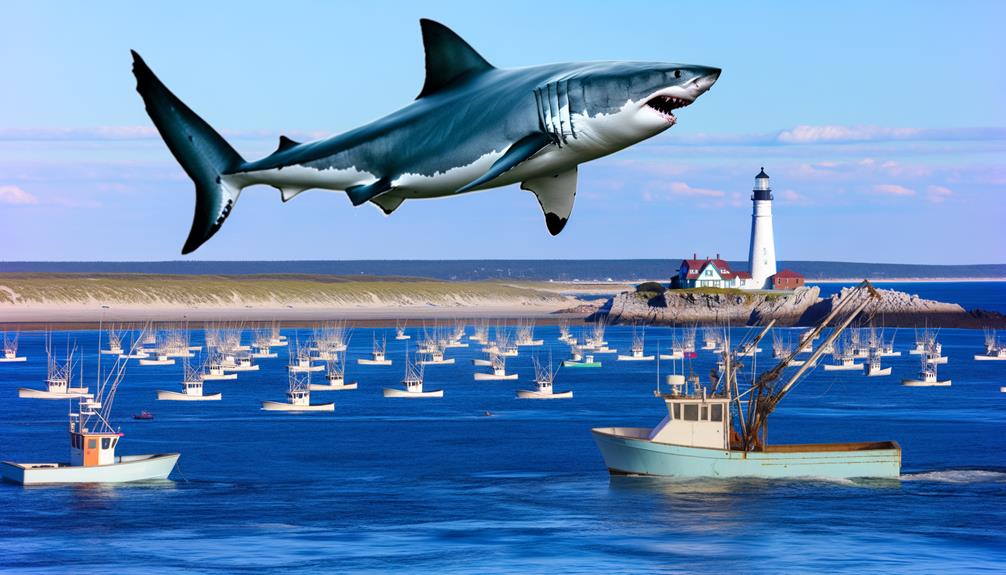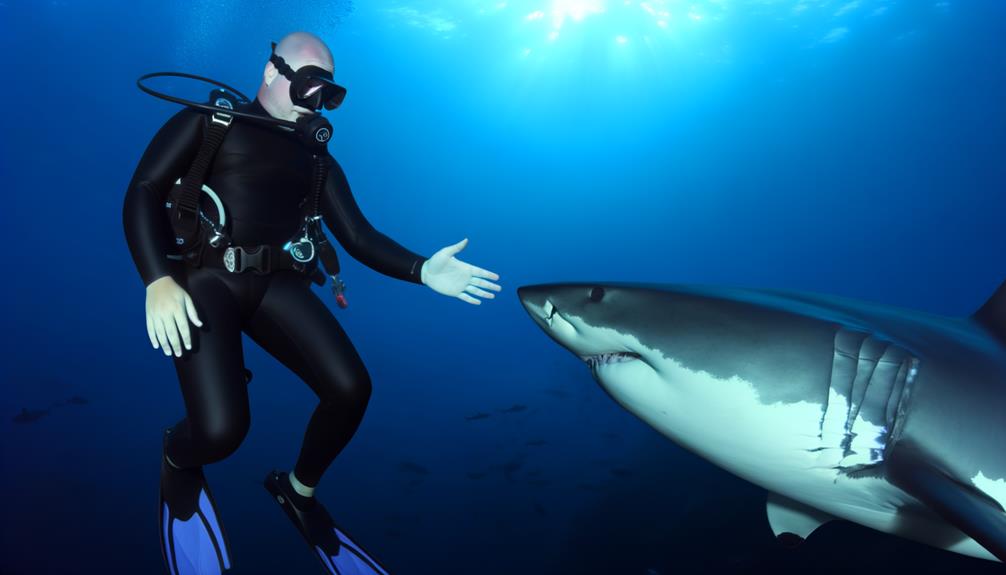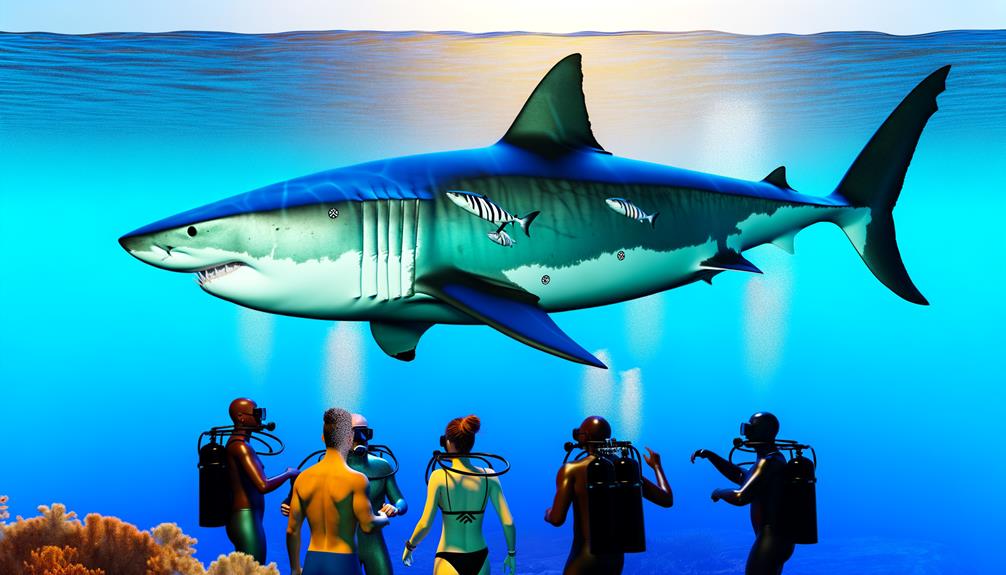In the marine-rich waters of Gloucester, Massachusetts, the recent sighting of a great white shark by local residents has stirred a wave of excitement and concern within the community.
The encounter, documented through compelling visual evidence, has reignited discourses on the intricate balance between human activity, wildlife conservation, and public safety.
This incident, while awe-inspiring, also serves as a stark reminder of the proximity of these powerful creatures to our shores, raising pertinent questions about their increasing presence and the subsequent implications on local ecosystems and recreational practices.
As we navigate through this multifaceted discussion, one thing becomes clear – the narrative of the great white shark in Gloucester, MA, is far from being a simple tale of maritime curiosity.
Key Takeaways
- Gloucester has a rich maritime history, with shipbuilding, commercial fishing, and trade being important industries.
- The number of great white sharks in the area has increased in recent years, particularly around Cape Cod and Gloucester.
- Great white shark sightings in Gloucester have been reported off Plum Island and Cape Hedge, with an increase during warmer months.
- Understanding shark behavior is important for fostering a sense of belonging and for environmental factors that influence hunting strategies.
Gloucester's Maritime History
Gloucester's maritime history, firmly rooted in the early 17th century, has been significantly shaped by its establishment as a fishing community, its role in the development of the Grand Banks fishing grounds, and the evolution of fishing technologies. This rich nautical legacy has been intertwined with the city's cultural and economic trajectory, with the advent of shipbuilding, commercial fishing, and trade playing pivotal roles.
The city's connection to the sea extends to the present day, with sightings of great white sharks in Gloucester's waters making news. These encounters, monitored by the Atlantic White Shark Conservancy's dedicated efforts, serve as a stark reminder of Gloucester's maritime heritage. This heritage is further epitomized by the iconic fishing schooners 'Lester G. Wass' and 'Gertrude L. Thebaud', symbols of a bygone era of the Grand Bank fishing schooners.
Today, Gloucester continues to honor and celebrate its maritime legacy through vibrant industry practices, annual events such as the Gloucester Schooner Festival, and the Fisherman's Memorial Statue. Each great white shark sighting further solidifies Gloucester's identity as a city with deep roots in the ocean's ecosystem.
Great White Shark: A Profile
In the rich tapestry of Gloucester's maritime ecosystem, the great white shark emerges as a formidable presence, its frequent sightings and behavioral patterns meticulously tracked by the Atlantic White Shark Conservancy (AWSC) using a sophisticated tool known as the Sharktivity app.
This crowd-sourced platform records data from acoustic tags and publicly submitted photos, painting a detailed picture of the great white shark's movement patterns. Notably, the number of great white sharks has surged in recent years, a testament to successful conservation efforts. The white shark was spotted frequently around Cape Cod; one great white shark lurking was even photographed, underscoring their increased presence.
Despite the spike in shark sightings, a shark bite was reported only occasionally, attesting to the rarity of attacks in Massachusetts. This juxtaposition of frequent sightings and infrequent incidents creates a captivating profile of the Cape Cod shark.
The Sharktivity app aims to maintain this status quo by providing real-time information on confirmed sightings and tracking data, enhancing public safety in the face of the awe-inspiring great white shark's presence in Gloucester's maritime ecosystem.
Gloucester's Great White Sightings

Tracking the movements of the great white sharks in the coastal waters of Massachusetts, specifically near Gloucester, has revealed intriguing patterns and frequencies in their sightings, as reported by the Atlantic White Shark Conservancy (AWSC) through their Sharktivity app. This great white shark tracked by Ocearch was spotted off Plum Island, and another near Cape Hedge in Gloucester, according to the Gloucester Daily Times.
| Year | Location | Sightings |
|---|---|---|
| 2016 | Off Plum | 1 |
| 2017 | Cape Hedge | 1 |
| 2018 | Off Plum | 2 |
| 2019 | Cape Hedge | 2 |
| 2020 | Both Locations | 3 |
The data shows that one great white shark was spotted cruising near the coast in 2016, and since then sightings typically peak during the warmer months. Remarkably, this shark has also traveled far from its expected habitat, indicating a broader range. The presence of whites have been spotted with a frequency that suggests a healthy, thriving population. The AWSC's tracking efforts and crowd-sourced data from engaged, local residents have been instrumental in these discoveries.
Understanding Shark Behavior
To comprehend the behavior of the Great White Shark in Gloucester, it is essential to scrutinize their communication methods and predatory patterns.
The sharks exhibit complex social hierarchies and communicate through various means such as body posturing, scent marking, and vocalizations.
Moreover, analyzing their distinct hunting strategies, and the influence of environmental factors on these strategies, provides substantial insight into their behavioral patterns.
Shark Communication Methods
Delving into the complex world of shark behavior, it becomes evident that these creatures employ a variety of communication methods – ranging from body language and chemical cues to vocalizations, visual displays, and electrical signals – to interact with their surroundings and each other.
The Atlantic White Shark Conservancy's Sharktivity has reported multiple sightings of great whites near the Cape Cod National Seashore and Great Point Light. These tracked sharks, named by the Cape community, have already demonstrated varied communication methods.
- Body language: reported by multiple witnesses during sightings.
- Chemical cues: believed to cause the shark bite near Peaks.
- Vocalizations: detected in studies by Sharktivity.
- Electrical signals: used in navigation around Cape.
Understanding shark behavior fosters a sense of belonging among enthusiasts and researchers alike.
Predatory Patterns Analysis
In the realm of shark behavior analysis, understanding the predatory patterns of the Great White Shark in Gloucester, Massachusetts, offers valuable insights into their hunting strategies, feeding patterns, prey identification, and the environmental influences on their behavior.
Scientific data from the Atlantic White Shark Conservancy's Sharktivity application reveals that at least one great white frequents the waters from Great Hill Beach to Long Beach between Brier Neck and Cape Hedge.
Breaking news coverage delivered by ISLAND Cod highlights rare bite marks along seals, indicative of their predatory behavior.
Seasonal changes and proximity to the Long Point Light Station also impact their feeding patterns.
These findings provide a snapshot into the complex dynamics of this iconic species in this unique Atlantic region.
Interaction Between Sharks and Humans

The relationship between humans and sharks, particularly in the coastal waters of New England, is a complex interplay of conservation efforts, technological advances, and public safety measures, with the Sharktivity app playing a significant role in monitoring shark behavior and promoting safety.
The White Shark Conservancy's Sharktivity app is a leading tool in this undertaking, aiding in the tracking and monitoring of Atlantic sharks.
The interaction can be broken down into the following key aspects:
- Utilizing acoustic tags and Smart Position and Temperature Tags, the Sharktivity app provides real-time data about shark movements, with at least one great white shark recently spotted in a rare sighting off the coast of Great Island.
- Conservation laws have resulted in a thriving marine ecosystem, bringing both seals and another great white shark back to the waters east of Wellfleet's National Seashore.
- The rarity of shark attacks underscores the need for residents to remain vigilant, especially during the peak months of May to October.
- The National Seashore is reminding the public to adhere to safety guidelines, underlining the importance of education and awareness in preventing accidents.
Local Research on Great Whites
Building on the aforementioned interactions between humans and sharks, local research spearheaded by the Atlantic White Shark Conservancy sheds further light on the presence and behavior of great whites in the waters off Gloucester, MA. A great white shark was reported lurking off the east coast, triggered by the rebound of the seal population. This was confirmed when a boater snapped a photo near Great Island and Great Beach, while multiple witnesses at Long Beach reported similar sightings.
The Sharktivity app, a tool developed by the conservancy, reported that sharks were detected last summer in greater numbers than before. This tool allows residents to remain informed and safe, while contributing to the data collection by reporting sightings. It creates a sense of community and belonging, as each report aids in the overall conservation efforts.
The seal suffering from bite wounds, witnessed near the shore, indicated the great white's recent presence. While white sharks were also spotted around the seal colonies, it is vital to remember that attacks on humans are rare. It is through such detailed, scientific research and public participation that we better understand and coexist with these magnificent creatures.
Preservation Efforts in Gloucester

As part of the conservation endeavors, the Atlantic White Shark Conservancy confirmed a sighting of a great white shark off Plum Island, marking a notable stride in Gloucester's preservation efforts. This sighting, along with others along the east coast of Great, lends credence to the fact that at least one great white shark was detected last year.
The ecological balance is being restored, despite the Point Light Station suffering from environmental changes. Evidence of this includes:
- The increasing presence of great white sharks around Gloucester's coast.
- A wounded seal was found on Long Beach between Brier Neck and Cape Hedge, implying shark activity.
- The Sharktivity app's data, which showed increased shark activity around Gloucester's Beach.
- The success of the Marine Mammal Protection Act in aiding the recovery of seals, a staple in the shark's diet.
These points indicate the success of preservation efforts in Gloucester, as the presence of these apex predators is indicative of a healthy marine ecosystem. The predator-prey relationship, punctuated by the occasional shark bite, offers a glimpse into the revival of natural processes in the region's marine life.
Shark Tourism in Massachusetts
While the resurgence of great white sharks in Gloucester's waters signifies a thriving ecosystem, it simultaneously fuels a burgeoning interest in shark tourism in Massachusetts, driven significantly by technology and conservation successes. Data from the Sharktivity app, which tracks shark movements primarily through crowd-sourcing, shows that sightings typically peak between August and October, the busiest months for Cape Cod tourism. The app showcases where great whites have been reported, such as when Ocearch pinged off Jenness Beach or around Billingsgate Island in Eastham.
In the waters off the coast, seals, a favorite prey of great whites, are also thriving thanks to environmental legislation. This dynamic ecosystem, stretching from Island and Great Hill to other coastal areas, has become a unique tourist attraction.
| Sightings Area | Shark Activity Month | Key Species |
|---|---|---|
| Jenness Beach | August to October | Great White |
| Billingsgate Island | August to October | Great White |
| Island and Great Hill | August to October | Seal |
| Gloucester | August to October | Great White |
| Massachusetts Coast | August to October | Seal |
The detailed scientific data provided by apps like Sharktivity not only enhances public safety but also fuels the state's flourishing shark tourism.
Frequently Asked Questions
Are There Sharks in Gloucester?
Yes, there are sharks in Gloucester. Sightings are confirmed by the Atlantic White Shark Conservancy, often due to the seal abundance. Beach safety is prioritized, and shark behavior is tracked for conservation efforts and local impact.
Are There Great White Sharks in Massachusetts?
Yes, there are great white sharks in Massachusetts. Shark sightings are common, particularly due to seasonal patterns. Safety measures, public awareness, and shark tracking contribute to conservation efforts while minimizing local and tourist impact.
Are There Sharks in Rockport Ma?
Yes, sharks have been sighted in Rockport, MA. Local fauna, ocean temperatures, and fishermen's experiences contribute to these sightings. Safety measures are in place, and public reactions influence tourism and the broader predator ecosystem.
Does Rockport Beach Have Sharks?
Yes, shark sightings, including Great Whites, occur at Rockport Beach. Local precautions and lifeguard strategies ensure visitor safety, while education programs foster understanding of sea life diversity and marine ecosystems, mitigating tourism impact.
Conclusion
In conclusion, Gloucester's maritime history, enriched by encounters such as the Buxbaums' with the great white, underscores the delicate balance between human activity and marine life.
The need for continued research and preservation efforts is clear as day, with shark tourism adding a new chapter to this tale.
These fascinating creatures, the 'knights' of the ocean, are a testament to nature's power, requiring both respect and understanding to ensure a harmonious coexistence.
